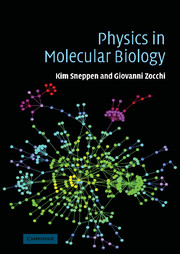Book contents
- Frontmatter
- Contents
- Preface
- Introduction
- 1 What is special about living matter?
- 2 Polymer physics
- 3 DNA and RNA
- 4 Protein structure
- 5 Protein folding
- 6 Protein in action: molecular motors
- 7 Physics of genetic regulation: the λ-phage in E. coli
- 8 Molecular networks
- 9 Evolution
- Appendix Concepts from statistical mechanics and damped dynamics
- Glossary
- Index
9 - Evolution
Published online by Cambridge University Press: 06 July 2010
- Frontmatter
- Contents
- Preface
- Introduction
- 1 What is special about living matter?
- 2 Polymer physics
- 3 DNA and RNA
- 4 Protein structure
- 5 Protein folding
- 6 Protein in action: molecular motors
- 7 Physics of genetic regulation: the λ-phage in E. coli
- 8 Molecular networks
- 9 Evolution
- Appendix Concepts from statistical mechanics and damped dynamics
- Glossary
- Index
Summary
Evolution and evolvability
Evolution, and the ability to evolve, is basic to life. In fact, it separates life from non-life. The process of evolution has brought us from inorganic material in ∼3.5 billion years, our bacterial ancestors in ∼2 billion years, from primitive seadwelling chordates in ∼500 million years and from common ancestors to mice in only ∼100 million years. Evolution has inspired our way of looking at life processes throughout modern biology, including the idea that evolvability is an evolving property in itself.
Most mutations are either without any consequences, i.e. neutral, or deleterious. Thus evolution is a costly process where most attempts are futile. That it works anyway reflects the capacity of life to copy itself so abundantly that it can sustain the costly evolutionary attempts.
Evolution is the necessary consequence of:
heredity (memory);
variability (mutations);
each generation providing more individuals than can survive (surplus).
The last of these points implies selection, and thus the principle of “survival of the fittest”. In fact, the surplus provided by growth of successful organisms is so powerful that it provides a direct connection between the scale of the molecule and the worldwide ecological system: a successful bacterium with a superior protein for universal food consumption may in principle fill all available space on Earth within a few days. In fact, bacteria on Earth number about 5 × 1030 (Whitman et al., 1998), a biomass that dominates all other animal groups together. The bacteria have already won! The dynamics of this interconnected microbiological ecosystem thus challenges any model built on a separation of phenomena at small and larger length scales.
Information
- Type
- Chapter
- Information
- Physics in Molecular Biology , pp. 245 - 279Publisher: Cambridge University PressPrint publication year: 2005
